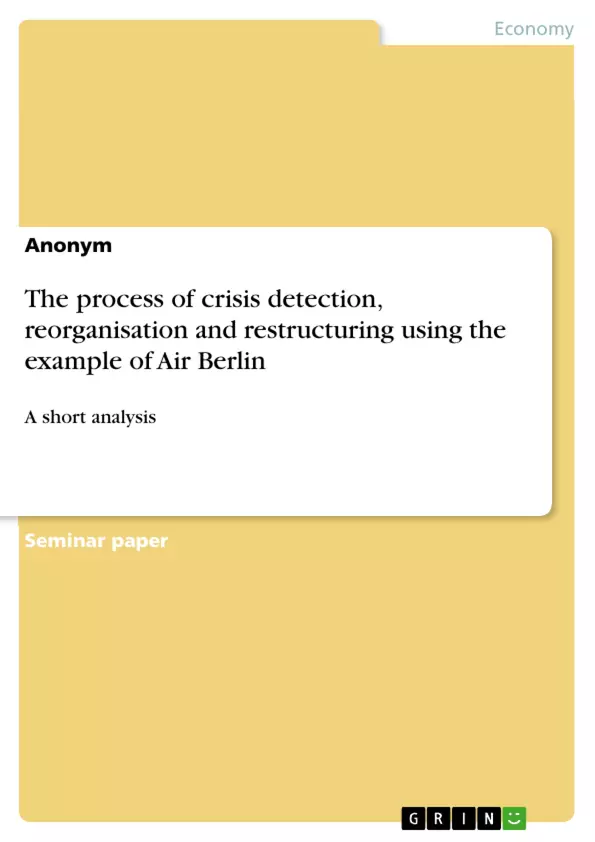This assignment investigates the process of crisis detection, reorganisation and restructuring using the example of Air Berlin. In August 2017, Air Berlin went insolvent as the company has not been able to turnaround the crisis, they have been stuck in.
First of all, the analysis focuses on the time before and at the beginning of Air Berlin’s crisis. Afterwards, internal and external factors that influenced Air Berlin’s business pre-crisis will be examined to analyze their state in the market. When the crisis occurred, investigation focuses on the different stages of crises through which Air Berlin went by analyzing all relevant financial figures. It is of interest how they reacted to the crisis financially, operationally and strategically. The goal of this research is to elaborate Air Berlin’s crisis and examine key facts that led to the total dissolution in 2017.
Inhaltsverzeichnis (Table of Contents)
- Introduction
- SWOT analysis
- Indicators of crisis
- Reaction and turnaround process
- Insolvency proceeding
- Conclusion
Zielsetzung und Themenschwerpunkte (Objectives and Key Themes)
This assignment explores the process of crisis detection, reorganisation, and restructuring using the example of Air Berlin. The analysis focuses on the period before and during the onset of the crisis, examining both internal and external factors that influenced Air Berlin's business. The research aims to elaborate on Air Berlin's crisis and examine key facts that led to the total dissolution in 2017.
- The impact of internal and external factors on Air Berlin's business performance.
- Analysis of the different stages of crisis through which Air Berlin went, including stakeholder, strategic, product, and sales crises.
- Examination of financial figures and operational strategies employed by Air Berlin in response to the crisis.
- Evaluation of the company's financial, operational, and strategic decisions during the crisis.
- Identification of key factors that ultimately led to Air Berlin's insolvency.
Zusammenfassung der Kapitel (Chapter Summaries)
- Introduction: Provides an overview of the research, focusing on the crisis faced by Air Berlin, its core business, and the scope of the analysis.
- SWOT analysis: Examines the market position of Air Berlin at the beginning of the crisis, highlighting its strengths, weaknesses, opportunities, and threats. This section analyzes the company's brand awareness, market share, competitive advantages, and the challenges it faced.
- Indicators of crisis: Delves into the different stages of crisis experienced by Air Berlin, including the stakeholder, strategic, product, and sales crises. This chapter analyzes indicators of each crisis stage, such as customer satisfaction ratings, stock price fluctuations, and financial performance.
Schlüsselwörter (Keywords)
The key words and focus topics of this work include Air Berlin, crisis management, airline industry, SWOT analysis, stakeholder crisis, strategic crisis, product and sales crisis, financial performance, market share, competitive advantage, low-cost carriers, full-service airlines, and insolvency.
- Citation du texte
- Anonym (Auteur), 2020, The process of crisis detection, reorganisation and restructuring using the example of Air Berlin, Munich, GRIN Verlag, https://www.grin.com/document/960374



